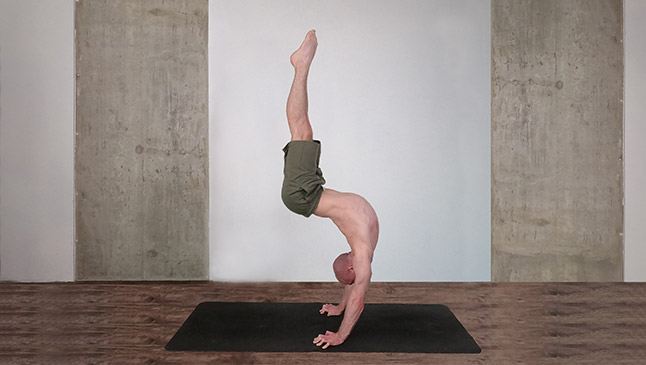Hollowback Handstand

Contents
A hollowback handstand is characterized by an arched back and a deep curve in the spine, resembling an elegant arch. Unlike a traditional handstand with a straight line from wrists to feet, the hollowback variation involves bending at the hips and creating a graceful curvature.
Pose Detail
- Advanced: Handstands
Step-by-Step Instructions
Benefits and Contraindications
Strengthening the Back and Core
Opening the Heart and Shoulders
Enhancing Body Awareness
Elevating Artistry
Back Issues
Shoulder Problems
Neck Problems
Lack of Core Strength
Hip Flexor Tightness
Wrist Issues
Blood Pressure Concerns
Pregnancy
Challenges and Tips
- Shoulder and Back Flexibility: Consistent stretching and mobility work for the shoulders and spine are key to achieving the hollowback shape.
- Balance and Entry: Finding balance in the hollowback position can be challenging. Practice controlled entries and exits to build stability.
- Mindful Breathing: Maintain steady and mindful breath throughout the pose to enhance relaxation and focus.
Final Thoughts
The hollowback handstand transcends the physical realm, embodying strength, grace, and artistry. As you embark on the journey to master this pose, remember that patience, dedication, and a deep connection with your body are paramount. Whether you’re drawn to its visual allure or the challenge it presents, the hollowback handstand offers an opportunity to elevate your yoga practice to new heights, both physically and artistically.
Frequently Asked Questions
Hollowback handstands are considered advanced poses. It’s recommended that beginners build a strong foundation in handstands, backbends, and core strength before attempting the hollowback variation.
Balancing in a hollowback handstand requires core engagement, shoulder stability, and proper alignment. Practice against a wall initially, and gradually work on maintaining balance in the pose.
Common mistakes include overarching the lower back, collapsing in the shoulders, and losing engagement in the core. Practitioners should focus on maintaining the arch while evenly distributing weight through the hands.
To exit safely, lower one leg at a time while maintaining control and engaging your core. Practice controlled exits against a wall to build confidence.
Transitioning from a regular handstand to a hollowback handstand requires advanced core strength and back flexibility. It’s recommended to first master both poses individually before attempting the transition.
Progression involves consistent practice of preparatory exercises, refining your technique, and seeking guidance from experienced yoga instructors or attending workshops focused on advanced inversions.
Variations and Progressions
- Hollowback with Straight Legs
- Press to Hollowback
- Hollowback Forearm Stand
Top Preparatory Exercises
- Shoulder Mobility and Warm-Up
- Downward Facing Dog Pose
- Extended Puppy Pose
- Wheel Pose
- Camel Pose
- Plank Pose
- Side Plank Pose
- Dolphin Plank Pose
- One Legged Dolphin Pose
- Complete Boat Pose
- Half Boat Pose
- One Legged Half Boat Pose
- Crescent Low Lunge Pose
- One-Legged King Pigeon Pose B
- Bridge Pose
- Dolphin Pose
- Wall-Assisted Hollowbacks
Top Follow-Up Exercises
- Straddle Hollowback Handstand
- Pike Hollowback Presses
- Hollowback Straightening the Legs
- Forearm Stand Hollowbacks: